Introduction
For satellites in low Earth orbit (below approximately 400 km) atmospheric drag is a large perturbing force. The atmospheric drag can be calculated from: \[ \mathbf{F}_d = -\frac{1}{2}\rho C A|\mathbf{v}|\mathbf{v}\] where:- $\rho$ is the atmospheric density
- $C$ is the drag coefficient
- $A$ is the cross-sectional area of the satellite perpendicular to the direction of motion
- $\mathbf{v}$ is the velocity of the satellite and $|\mathbf{v}|$ is its magnitude
This project is based on parts of my work at CNES, however all code and results are entirely my own.
Modelling Principles
For altitudes higher than 120 km, the DTM 77 model developed by Barlier, Berger, Falin, Kockarts and Thuillier in 1977 uses a spherical harmonic expansion to calculate the temperature as well as the concentrations of Helium (He), molecular Nitrogen (N$_2$) and Oxygen (O). These are all functions of altitude, latitude, solar time and solar and geomagnetic activity.To start with we assume that we can break the atmosphere up into independent vertical columns. Inside each column the diffusive equilibrium equations holds: \begin{equation}\label{eq:equilibrium} \frac{d \eta_i}{\eta_i} = -\frac{m_i g}{k T}dz - \frac{1 + \alpha_i}{T}dT\end{equation} where:
- $\eta_i$ is the concentration of species $i$, (either He, N$_2$ or O)
- $m_i$ is the mass of species $i$
- $g$ is the acceleration due to gravity
- $k$ is the Boltzmann constant
- $T$ is the temperature
- $\alpha_i$ is the thermal diffusion factor for species $i$
Solving the Diffusive Equilibrium Equation
Let us assume a temperature profile of the following form: \[T(z) = T_\infty - (T_\infty - T_{120})\exp(-\sigma\xi)\] with:- $T_\infty$ is the thermopause temperature
- $T_{120}$ is the constant temperature at the lower boundary of 120 km
- $\xi = \frac{(z - 120)(R + 120)}{R + z}$ is the geopoential altitude ($R$ = 6356.77 km and $z$ is measured in km)
- $\sigma = s + \frac{1}{R + 120}$, with $s$ the temperature gradient parameter
- $a = \frac{T_\infty - T_{120}}{T_\infty}$
- $\gamma_i = \frac{m_i g_{120}}{\sigma k T_{\infty}}$, with $g_{120}$ the gravitational acceleration at 120 km
- the local solar time $t$
- the latitude $\varphi$
- the day count of the year $d$
- the daily 10.7 cm solar flux $f$ measured on day $d-1$
- the average solar flux $\bar{f}$ over 3 solar rotations centred on day $d$
- the three hour planetary index $k_p$ taken 3 hours before $t$.
- $\Omega = \frac{2\pi}{365 \text{ days}}$ is the approximate angular velocity of the Earth around the Sun
- $\omega = \frac{2\pi}{24 \text{ hours}}$ is the approximate rotational velocity of the Earth
- $P_i^j$ is the unnormalized associated Legendre polynomial of order $i$ and degree $j$
- The coefficients $a_q^0$, $b_p^0$, $\delta_p$, $c_n^m$ and $d_n^m$ have all been empirically calculated
- $\beta$ is a constant that depends on the constituent
Reducing the Coefficients
Several simplifications will be provided below to limit the total number of coefficients to 36 for each constituent (and $T_{\infty}$). Let us rename the coefficients to $A_1, \cdots, A_{36}$. $A_1$ will be the first coefficient in \eqref{eq:concentrations} or \eqref{eq:temperature}.The terms in $G(L)$ can be approximated as: \begin{align*} &F = A_4(f - \bar{f}) + A_5(f - \bar{f})^2 + A_6(\bar{f} - 150)\\ &M = (A_7 + A_8 P_2^0(\sin(\varphi)))k_p\\ &\sum\limits_{q = 0}^{\infty} a_q^0 P_q^0(\sin(\varphi)) \approx A_2 P_2^0(\sin(\varphi)) + A_3P_4^0(\sin(\varphi))\\ &\sum\limits_{p = 1}^{\infty} b_p^0 P_p^0(\sin(\varphi))\cos(p\Omega(d - \delta_p)) \approx AN1 + AN2 + SAN1 + SAN2\\ &\sum\limits_{n= 1}^{\infty} \sum\limits_{m = 1}^n \left(c_n^m P_n^m(\sin(\varphi))\cos(m\omega t) + d_n^m P_n^m(\sin(\varphi))\sin(m \omega t)\right) \approx D + SD + TD \end{align*} The symmetric annual term $AN1$ and the symmetric semi-annual term $SAN1$ are expressed as: \begin{align*} &AN1 = (A_9 + A_{10} P_2^0(\sin(\varphi)))\cos(\Omega(d - A_{11})\\ &SAN1 = (A_{12} + A_{13} P_2^0(\sin(\varphi)))\cos(2\Omega(d - A_{14}) \end{align*} These terms are symmetric around the equator. The annual term $AN2$ and semi-annual term $SAN2$ are anti-symmetric around the equator and are expressed as: \begin{align*} &AN2 = (A_{15}P_1^0(\sin(\varphi)) + A_{16} P_3^0(\sin(\varphi)) + A_{17}P_5^0(\sin(\varphi)))\cos(\Omega(d - A_{18})\\ &SAN2 = A_{19}P_1^0(\sin(\varphi))\cos(2\Omega(d - A_{20}) \end{align*} The diurnal term $D$ is given by: \begin{align*} D = \bigl(A_{21}P_1^1(\sin(\varphi)) &+ A_{22}P_3^1(\sin(\varphi)) + A_{23}P_5^1(\sin(\varphi)) \\ & + (A_{24}P_1^1(\sin(\varphi)) + A_{25}P_2^1(\sin(\varphi)))\cos(\Omega(d - A_{18}))\bigr)\cos(\omega t) \\ &+\bigl(A_{26}P_1^1(\sin(\varphi)) + A_{27}P_3^1(\sin(\varphi)) + A_{28}P_5^1(\sin(\varphi)) \\&+ (A_{29}P_1^1(\sin(\varphi)) + A_{30}P_2^1(\sin(\varphi)))\cos(\Omega(d - A_{18}))\bigr)\sin(\omega t) \end{align*} The semidiurnal term $SD$ is given by: \begin{align*} SD &= \left(A_{31}P_2^2(\sin(\varphi)) + A_{32}P_3^2(\sin(\varphi))\cos(\Omega(d - A_{18}))\right)\cos(2\omega t) \\ &+\left(A_{33}P_2^2(\sin(\varphi)) + A_{34}P_3^2(\sin(\varphi))\cos(\Omega(d - A_{18}))\right)\sin(2\omega t) \end{align*} Finally the tridiurnal term $TD$ is given by: \[ TD = A_{35} P_3^3(\sin(\varphi))\cos(3\omega t) + A_{36}P_3^3(\sin(\varphi))\sin(3\omega t)\]
The coefficients are available here, in column order $T_{\infty}$, He, O and N$_2$. Note that there are multiple typos in the coefficients provided in the original paper by Barlier et al.
Code
MATLAB code for the DTM 77 model is available here.Model Data
To complete the model the following empirical constants are given in the paper:| Constant | Value | Units |
| $T_{120}$ | 380 | K |
| $s$ | 0.02 | km$^{-1}$ |
| $\alpha$ | -0.38 for He 0 for N$_2$ and O |
- |
| $\beta$ | 1 + F1 for $T_\infty$, O, N$_2$ 1 for He |
- |
In addition the following constants are needed, though not given in the paper:
| Constant | Value | Units |
| $g_{120}$ | $9.5021268\times 10^{-3}$ | km s$^{-2}$ |
| $k$ | $1.38064852\times 10^{-29}$ | km$^2$ kg s$^{-2}$ K$^{-1}$ |
| mass of He | $6.6464764\times 10^{-27}$ | kg |
| mass of O | $2.6567626\times 10^{-26}$ | kg |
| mass of N$_2$ | $4.651734\times 10^{-26}$ | kg |
Results
We shall now test this model by recreating some of the plots in the original paper by Barlier et al.Solar activity sensitivity
The first test we will cover the sensitivity of the temperature, density and concentrations on the solar activity. Holding fixed the following parameters:- $d = 264$
- $\varphi = 0$
- $z = 400$ km
- $k_p = 2$
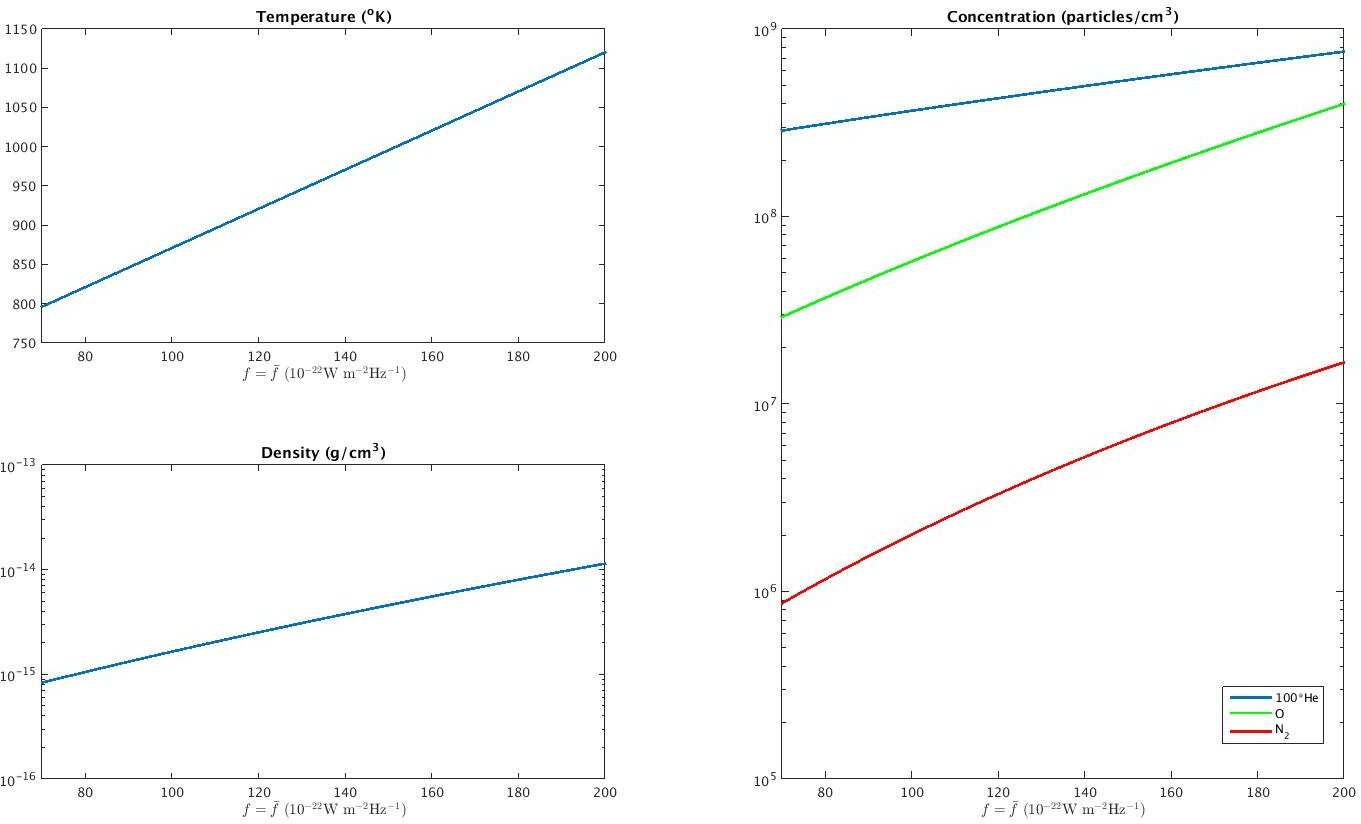 |
Holding $\bar{f}$ constant at 130, we can vary the daily flux $f$ to study the effect of $f - \bar{f}$:
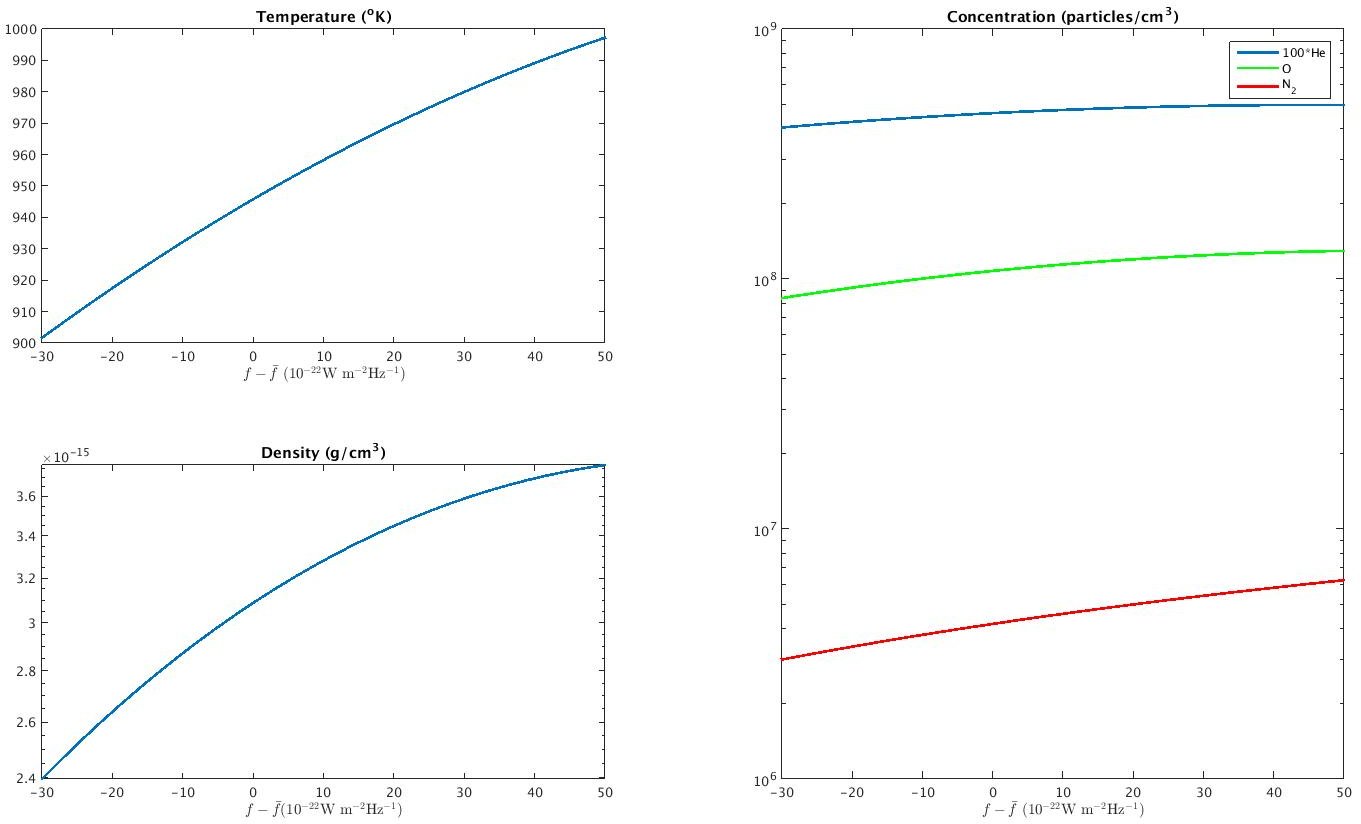 |
Day and solar time sensitivity
We can also look at the sensitivity of our model to the local solar time and the day of the year at various latitudes. Holding fixed the following parameters (high solar activity):- $z = 400$ km
- $f = \bar{f} = 150$
- $k_p = 2$
- $d = 180$ when varying $t$
- $t = 15$ when varying $d$
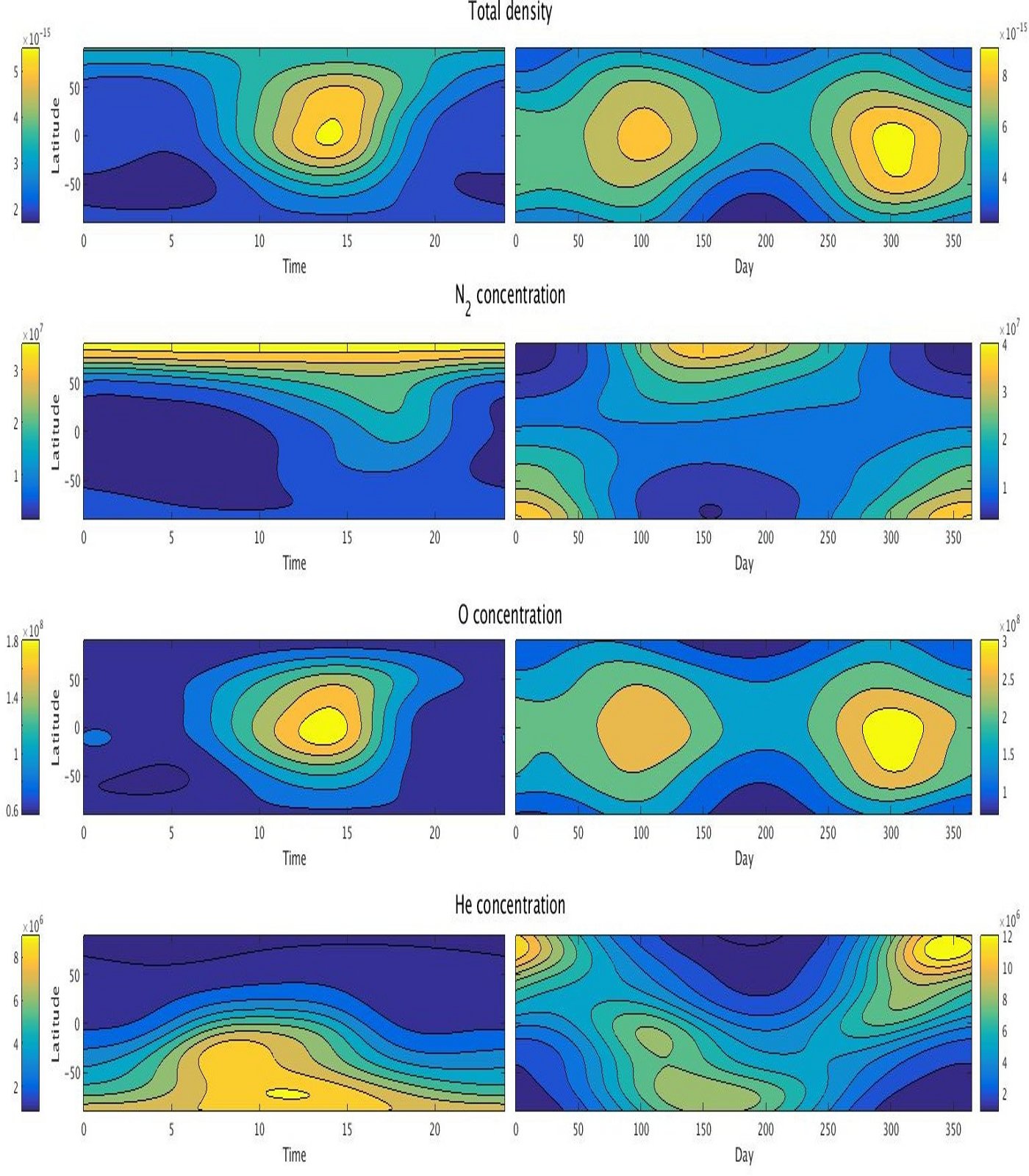 |
For low solar activity ($f = \bar{f} = 92$, $k_p = 1$, $z = 275$ km):
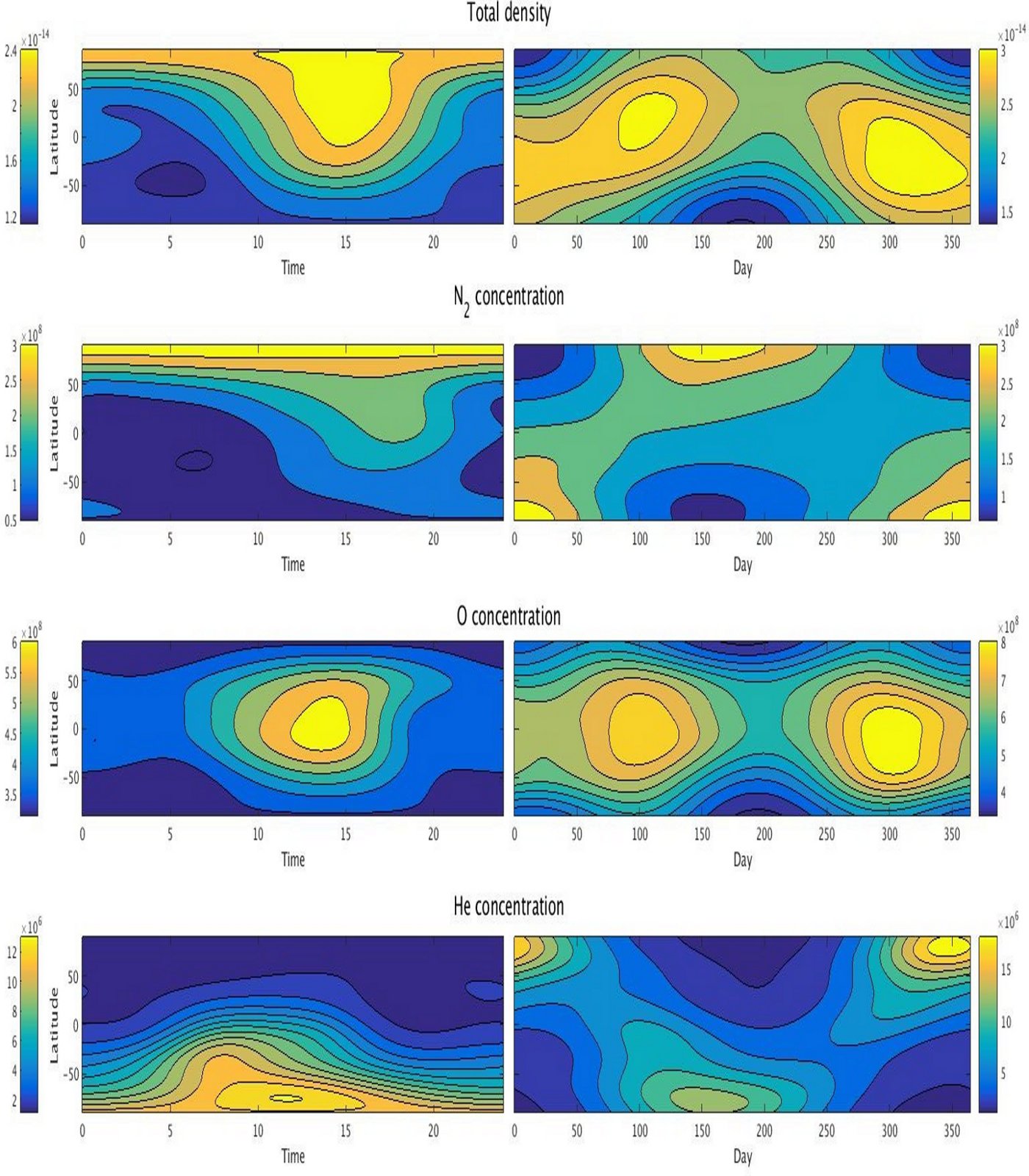 |
Looking at the annual average variation at the equator for high ($f = \bar{f} = 150$, $k_p = 2$ - left) and low ($f = \bar{f} = 92$, $k_p = 1$ - right) solar activity at 400 km above the equator:
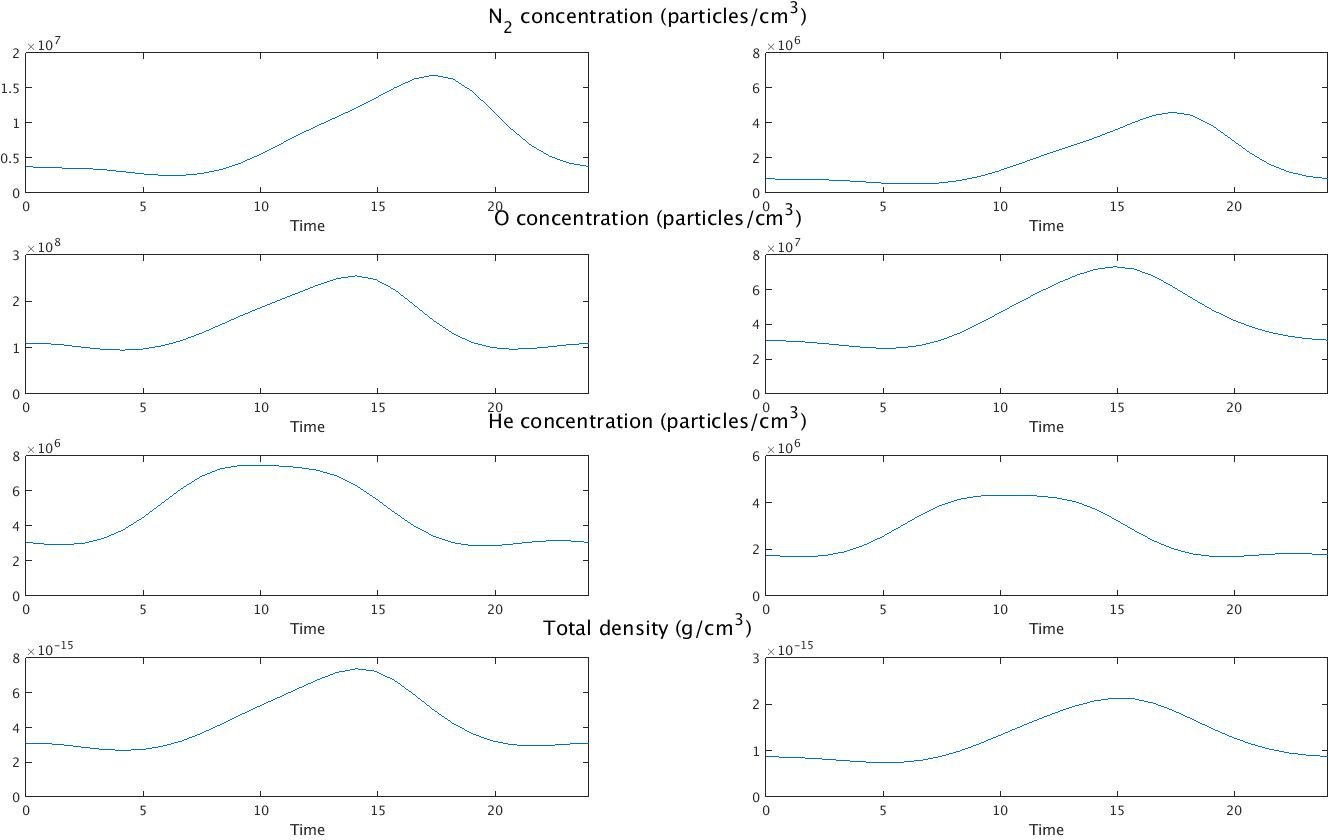 |
Another quantity of interest is the thermopause temperature. We can see how the daily average varies over a year while holding the following conditions fixed:
- $f = \bar{f} = 150$ $10^{-22}$Wm$^{-2}$Hz$^{-1}$
- $z = 400$ km
- $k_p = 2$
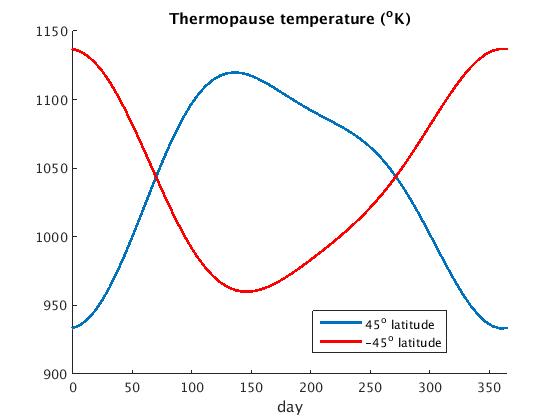 |